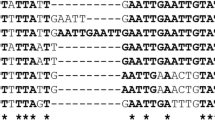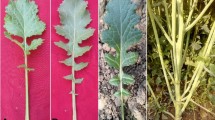Abstract
Search for genic SSRs from transcriptome sequence data of Brassica juncea and B. nigra and from unigene databank of B. rapa resulted in identification of 20,529 SSRs from 330,827 gene sequences. Identified SSRs (named as unigene microsatellite; UGM) were characterized based on their number of repeats, type of motif and base composition. Primers were designed for 2118 UGMs after in silico polymorphism survey and were tested across 11 different genotypes of B. juncea and B. rapa for PCR amplification and polymorphism. It resulted in clear-cut amplification from 1993 UGMs of which 1319 UGMs showed polymorphism. It was observed that a priori in silico polymorphism survey helped in increasing the polymorphism percentage (6.1–13.2) by PCR amplification. We also report here the development of first SSR-based linkage map of Brassica juncea using a DH mapping population derived from F1 of the cross between the lines EH-2 and Pusajaikisan. The map consisted of 860 markers comprising 462 UGMs, 157 BAC-derived SSRs and 241 intron polymorphic markers and covered a total genetic length of 2073.6 cM. The study also reports an interesting observation of appearance of novel non-parental bands in the mapping population from 18 SSRs and 13 IP markers. Search of Arabidopsis genes orthologous to their primer sequences showed that 11 of such Arabidopsis genes code for proteins involved in various abiotic stresses. The highly transferable genic SSRs developed in the study would serve as valuable resources for comparative genome mapping, mapping of qualitative and quantitative traits, gene cloning and marker-assisted breeding in Brassica species.






Similar content being viewed by others
References
Camacho C, Coulouris G, Avagyan V, Ma N, Papadopoulos J, Bealer K et al (2009) BLAST+: architecture and applications. BMC Bioinform 70:1
Chalhoub B, Denoeud F, Liu S, Parkin IAP, Tang H, Wang X et al (2014) Early allopolyploid evolution in the post-neolithic Brassica napus oilseed genome. Science 345(6199):950–953. doi:10.1126/science.1253435
Chauhan JS, Singh KH, Singh VV, Kumar S (2011) Hundred years of rapeseed-mustard breeding in India: accomplishments and future strategies. Indian J Agric Sci 81(12):1093–1109
Chotechung S, Somta P, Chen J, Yimram T, Chen X, Srinives P (2016) A gene encoding a polygalacturonase-inhibiting protein (PGIP) is a candidate gene for bruchid (Coleoptera: bruchidae) resistance in mungbean (Vigna radiata). Theor Appl Genet 129:1673. doi:10.1007/s00122-016-2731-1
Da Maia LC, Palmieri DA, De Souza VQ, Kopp MM, de Carvalho FI, Costa de Oliveira A (2008) SSR locator: tool for simple sequence repeat discovery integrated with primer design and PCR simulation. Int J Plant Genomics. doi:10.1155/2008/412696
Dhaka N, Rout K, Yadava SK, Sodhi YS, Gupta V, Pental D, Pradhan AK (2016) Genetic dissection of seed weight by QTL analysis and detection of allelic variation in Indian and east European gene pool lines of Brassica juncea. Theor Appl Genet. doi:10.1007/s00122-016-2811-2
Ellegren H (2004) Microsatellites: simple sequences with complex evolution. Nat Rev Genet 5(6):435–445. doi:10.1038/nrg1348
Gao C, Tang Z, Yin J, An Z, Fu D, Li J (2011) Characterization and comparison of gene-based simple sequence repeats across Brassica species. Mol Genet Genomics 286(2):161–170. doi:10.1007/s00438-011-0636-x
Gemayel R, Vinces MD, Legendre M, Verstrepen KJ (2010) Variable tandem repeats accelerate evolution of coding and regulatory sequences. Annu Rev Genet 44:445–477. doi:10.1146/annurev-genet-072610-155046
Hopkins CJ, Cogan NOI, Hand M, Jewell E, Kaur J, Li X et al (2007) Sixteen new simple sequence repeat markers from Brassica juncea expressed sequences and their cross-species amplification. Mol Ecol Notes 7(4):697–700. doi:10.1111/j.1471-8286.2007.01681.x
Izzah NK, Lee J, Jayakodi M, Perumal S, Jin M, Park B- et al (2014) Transcriptome sequencing of two parental lines of cabbage (Brassica oleracea L. var. capitata L.) and construction of an EST-based genetic map. BMC Genomics. doi:10.1186/1471-2164-15-149
Jurka J, Pethiyagoda C (1995) Simple repetitive DNA sequences from primates: compilation and analysis. J Mol Evol 40(2):120–126. doi:10.1007/BF00167107
Kashi Y, King DG (2006) Simple sequence repeats as advantageous mutators in evolution. Trends Genet 22(5):253–259. doi:10.1016/j.tig.2006.03.005
Kim H, Choi SR, Bae J, Hong CP, Lee SY, Hossain MJ et al (2009) Sequenced BAC anchored reference genetic map that reconciles the ten individual chromosomes of Brassica rapa. BMC Genomics 10:432. doi:10.1186/1471-2164-10-432
Kong Q, Zhang G, Chen W, Zhang Z, Zou X (2012) Identification and development of polymorphic EST-SSR markers by sequence alignment in pepper, Capsicum annuum (Solanaceae). Am J Bot 99(2):e59–e61. doi:10.3732/ajb.1100347
Kovalchuk O, Kovalchuk I, Arkhipov A, Hohn B, Dubrova YE (2003) Extremely complex pattern of microsatellite mutation in the germline of wheat exposed to the post-chernobyl radioactive contamination. Mutat Res Fundam Mol Mech Mutagen 525(1):93–101. doi:10.1016/S0027-5107(03)00006-X
Li Y, Korol AB, Fahima T, Nevo E (2004) Microsatellites within genes: structure, function, and evolution. Mol Biol Evol 21(6):991–1007. doi:10.1093/molbev/msh073
Li H, Younas M, Wang X, Li X, Chen L, Zhao B et al (2013) Development of a core set of single-locus SSR markers for allotetraploid rapeseed (Brassica napus L.). Theor Appl Genet 126(4):937–947. doi:10.1007/s00122-012-2027-z
Liu S, Liu Y, Yang X, Tong C, Edwards D, Parkin IAP et al (2014) The Brassica oleracea genome reveals the asymmetrical evolution of polyploid genomes. Nat Commun. doi:10.1038/ncomms4930
Merritt BJ, Culley TM, Avanesyan A, Stokes R, Brzyski J (2015) An empirical review: characteristics of plant microsatellite markers that confer higher levels of genetic variation. Appl Plant Sci. doi:10.3732/apps.1500025
Mukhopadhyay A et al (2007) High frequency production of microspore derived doubled haploid (DH) and its application for developing low glucosinolate lines in Indian Brassica juncea. In: Proceedings of the 12th international rapeseed congress. Wuhan, pp 333–335
Nagaharu U (1935) Genome analysis in Brassica with special reference to the experimental formation of B. napus and peculiar mode of fertilization. Jpn J Bot 7:389–452
Oliveira EJ, Pádua JG, Zucchi MI, Vencovsky R, Vieira MLC (2006) Origin, evolution and genome distribution of microsatellites. Genet Mol Biol 29(2):294–307
Panjabi P, Jagannath A, Bisht NC, Lakshmi KL, Sharma S, Gupta V et al (2008) Comparative mapping of Brassica juncea and Arabidopsis thaliana using intron polymorphism (IP) markers: homoeologous relationships, diversification and evolution of the A, B and C Brassica genomes. BMC Genomics. doi:10.1186/1471-2164-9-113
Paritosh K, Gupta V, Yadava SK, Singh P, Pradhan AK, Pental D (2014) RNA-seq based SNPs for mapping in Brassica juncea (AABB): synteny analysis between the two constituent genomes A (from B. rapa) and B (from B. nigra) shows highly divergent gene block arrangement and unique block fragmentation patterns. BMC Genomics 15(1):396. doi:10.1186/1471-2164-15-396
Pradhan AK, Gupta V, Mukhopadhyay A, Arumugam N, Sodhi YS, Pental D (2003) A high-density linkage map in Brassica juncea (Indian mustard) using AFLP and RFLP markers. TheorAppl Genet 106(4):607–614
Ramchiary N, Padmaja KL, Sharma S, Gupta V, Sodhi YS, Mukhopadhyay A, Arumugam N, Pental D, Pradhan AK (2007) Mapping of yield influencing QTL in Brassica juncea: implications for breeding of a major oilseed crop of dryland areas. Theor Appl Genet 115(6):807–817. doi:10.1007/s00122-007-0610-5
Ramchiary N, Nguyen VD, Li X, Hong CP, Dhandapani V, Choi SR et al (2011) Genic microsatellite markers in Brassica rapa: development, characterization, mapping, and their utility in other cultivated and wild Brassica relatives. DNA Res 18(5):305–320. doi:10.1093/dnares/dsr017
Rogers SO, Bendich AJ (1994) Extraction of total cellular DNA from plants, algae and fungi. In: Gelvin SB (ed) Plant molecular biology manual. Springer, Lafayette, pp 183–190
Schlötterer C (2004) The evolution of molecular markers—just a matter of fashion? Nat Rev Genet 5(1):63–69. doi:10.1038/nrg1249
Shi J, Huang S, Zhan J, Yu J, Wang X, Hua W et al (2014) Genome-wide microsatellite characterization and marker development in the sequenced Brassica crop species. DNA Res 21(1):53–68. doi:10.1093/dnares/dst040
Shirasawa K, Koilkonda P, Aoki K, Hirakawa H, Tabata S, Watanabe M et al (2012) In silico polymorphism analysis for the development of simple sequence repeat and transposon markers and construction of linkage map in cultivated peanut. BMC Plant Biol 12:1. doi:10.1186/1471-2229-12-80
Van Ooijen JW (2006) JoinMap 4, software for the calculation of genetic linkage maps in experimental populations. Kyazma BV, Wageningen
Varshney RK, Graner A, Sorrells ME (2005) Genic microsatellite markers in plants: features and applications. Trends Biotechnol 23(1):48–55. doi:10.1016/j.tibtech.2004.11.005
Victoria FC, da Maia LC, de Oliveira AC (2011) In silico comparative analysis of SSR markers in plants. BMC Plant Biol. doi:10.1186/1471-2229-11-15
Wang X, Wang H, Wang J, Sun R, Wu J, Liu S et al (2011) The genome of the mesopolyploid crop species Brassica rapa. Nat Genet 43(10):1035–1040. doi:10.1038/ng.919
Xu J, Qian X, Wang X, Li R, Cheng X, Yang Y et al (2010) Construction of an integrated genetic linkage map for the a genome of Brassica napus using SSR markers derived from sequenced BACs in B. rapa. BMC Genomics 11(1):1
Yang J, Liu D, Wang X, Ji C, Cheng F, Liu B, Hu Z et al (2016) The genome sequence of allopolyploid Brassica juncea and analysis of differential homoeolog gene expression influencing selection. Nat Genet 48(10):1225–1232. doi:10.1038/ng.3657
Yu S, Zhang F, Zhao X, Yu Y, Zhang D, Zhao X et al (2013) An improved Brassica rapa genetic linkage map and locus-specific variations in a doubled haploid population. Plant Mol Biol Rep 31(3):558–568
Zalapa JE, Cuevas H, Zhu H, Steffan S, Senalik D, Zeldin E et al (2012) Using next-generation sequencing approaches to isolate simple sequence repeat (SSR) loci in the plant sciences. Am J Bot 99(2):193–208
Acknowledgements
The study was funded by the National Dairy Development Board (NDDB) and also partly supported by the Department of Biotechnology, Department of Science & Technology and University Grant Commission, Government of India. N. Dhaka acknowledges the receipt of research fellowship from the Council of Scientific and Industrial Research (CSIR), India.
Authors’ contributions
The experiment was conceived and designed by ND, VG, DP and AKP and was performed by ND, KP and AM. The data was analyzed by ND, KP, VG and AKP and the manuscript was written and edited by ND, AM, DP and AKP.
Author information
Authors and Affiliations
Corresponding author
Ethics declarations
Conflict of interest
The authors declare that they have no competing interests.
Ethical approval
The manuscript entitled “Identification of genic SSRs and construction of a SSR-based linkage map in Brassica juncea” being submitted for publication in Euphytica complies with the current laws of India for academic and research purposes.
Electronic supplementary material
Below is the link to the electronic supplementary material.
Rights and permissions
About this article
Cite this article
Dhaka, N., Mukhopadhyay, A., Paritosh, K. et al. Identification of genic SSRs and construction of a SSR-based linkage map in Brassica juncea . Euphytica 213, 15 (2017). https://doi.org/10.1007/s10681-016-1814-z
Received:
Accepted:
Published:
DOI: https://doi.org/10.1007/s10681-016-1814-z




